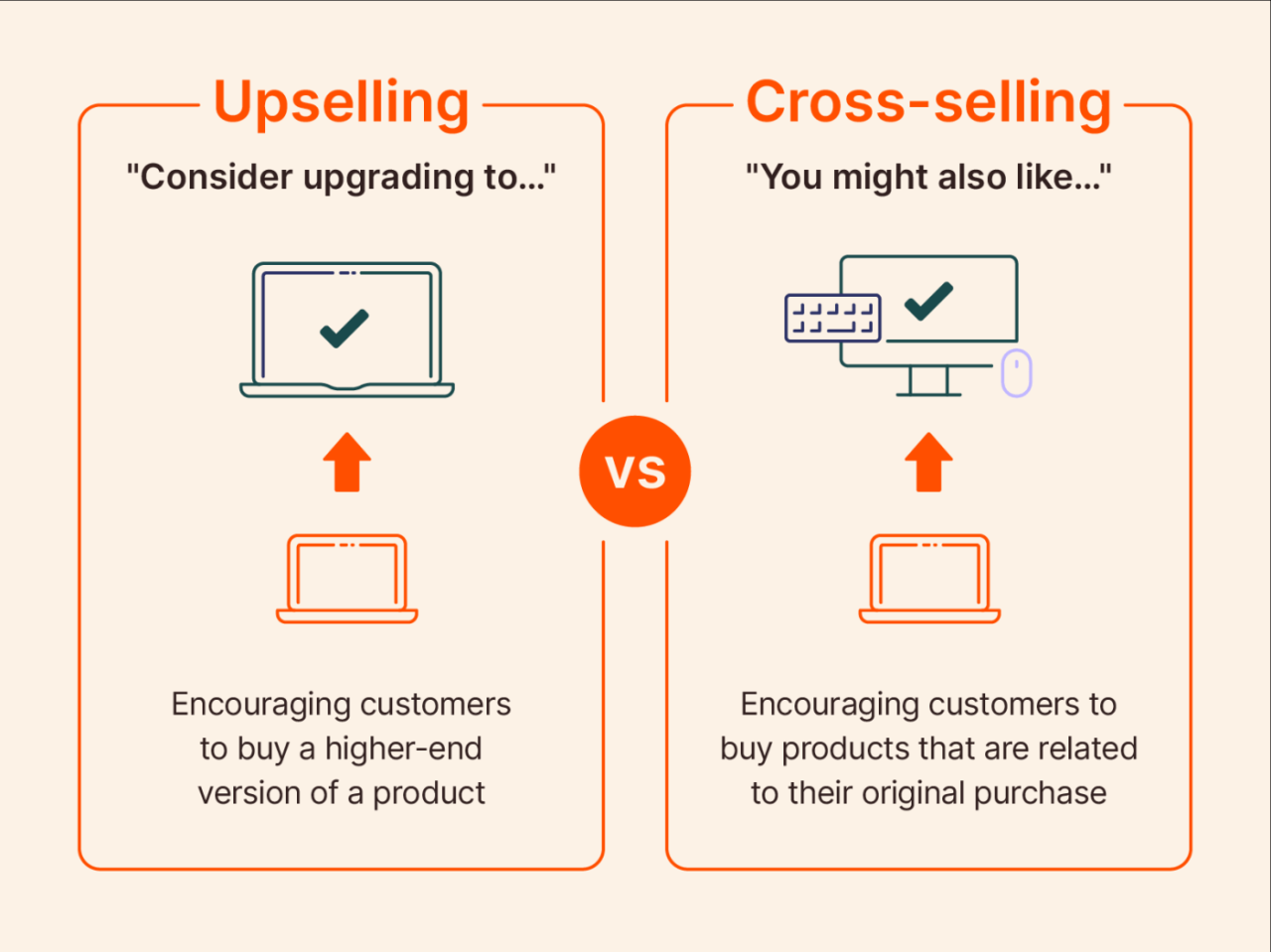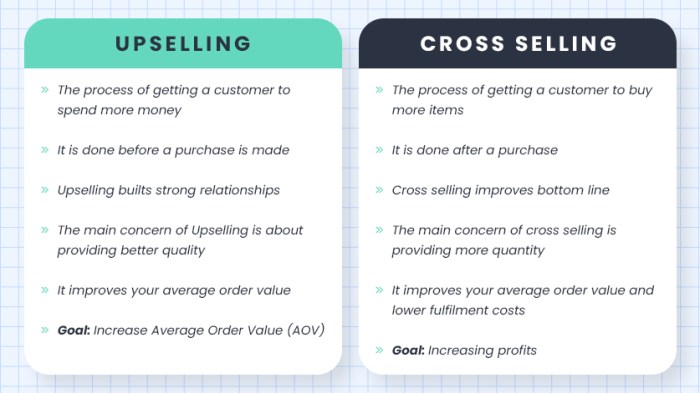Kicking off with Upselling and Cross-selling, this topic dives into the art of increasing revenue through strategic techniques. From upselling to cross-selling, get ready to explore how businesses can enhance customer experience and loyalty while driving sales.
Upselling Techniques

When it comes to upselling, there are various strategies that businesses can implement to increase revenue and enhance customer satisfaction. By offering customers additional products or services that complement their original purchase, businesses can boost their sales and build stronger relationships with their clientele.
Bundle Deals
One effective upselling technique is to offer bundle deals where customers can purchase multiple items together at a discounted price. This not only encourages customers to spend more but also adds value to their purchase by providing them with a complete solution.
Product Recommendations, Upselling and Cross-selling
Another strategy is to provide personalized product recommendations based on the customer’s preferences or past purchases. By suggesting relevant items that complement their original purchase, businesses can increase the likelihood of upselling and cross-selling additional products.
Loyalty Programs
Implementing loyalty programs that offer exclusive discounts or rewards to repeat customers can also be a successful upselling tactic. By incentivizing customers to make additional purchases, businesses can increase customer retention and drive higher sales.
Upselling at Checkout
Lastly, incorporating upselling opportunities at the checkout process, such as offering add-on items or upgrades, can be a simple yet effective way to increase the average order value. By presenting customers with relevant options right before they complete their purchase, businesses can capitalize on the opportunity to upsell.Overall, upselling plays a crucial role in maximizing revenue and enhancing customer satisfaction.
By implementing these upselling techniques, businesses can not only increase their sales but also provide customers with a more comprehensive and personalized shopping experience.
Cross-selling Strategies
When it comes to cross-selling, it’s important to understand the distinction between upselling and cross-selling. While upselling involves convincing a customer to purchase a more expensive version of the product they are already buying, cross-selling focuses on offering complementary or related products to enhance the customer’s overall purchase.
Identifying Complementary Products
One key approach to effectively cross-sell to customers is by identifying complementary products that go hand in hand with the main item they are purchasing. By understanding the customer’s needs and preferences, you can offer relevant products that add value to their purchase.
- Utilize customer purchase history to recommend products that are frequently bought together.
- Suggest products based on the customer’s current purchase to enhance their overall shopping experience.
- Personalize recommendations by taking into account the customer’s preferences and buying behavior.
Enhancing Customer Experience and Loyalty
Cross-selling not only boosts sales but also plays a significant role in enhancing customer experience and fostering loyalty. By offering additional products that meet the customer’s needs, you can create a more personalized shopping experience that resonates with them.
- Enhanced convenience for customers by providing all related products in one place.
- Increases customer satisfaction by offering solutions to their needs in a comprehensive manner.
- Builds trust and loyalty as customers feel understood and valued by the personalized recommendations.
Personalization in Upselling and Cross-selling
Personalization plays a crucial role in the success of upselling and cross-selling strategies. By tailoring recommendations and offers to individual customers based on their preferences, purchase history, and behavior, businesses can create a more engaging and relevant shopping experience. This not only increases the likelihood of a sale but also helps build customer loyalty and satisfaction.
Examples of Personalized Recommendations Driving Sales
- Amazon’s personalized product recommendations based on past purchases and browsing history have been incredibly effective in driving sales. Customers are more likely to make additional purchases when shown products that align with their interests.
- Streaming services like Netflix and Spotify use personalized recommendations to suggest content based on user preferences. This not only keeps customers engaged but also encourages them to explore new offerings, leading to increased subscription revenue.
Impact of Targeted Cross-selling
- Targeted cross-selling, where complementary products or services are suggested based on a customer’s previous purchases, can significantly boost sales. For example, a customer who buys a camera may also be interested in accessories like lenses, tripods, or memory cards.
- Retailers like Sephora use targeted cross-selling to recommend skincare products that complement a customer’s makeup purchases. This not only increases the average order value but also enhances the overall shopping experience.
Technology and Tools for Upselling and Cross-selling

In the digital age, technology plays a crucial role in enhancing upselling and cross-selling strategies. From AI to machine learning, businesses leverage advanced tools to personalize their approach and boost sales.
AI and Machine Learning in Upselling and Cross-selling
AI and machine learning algorithms analyze customer behavior, preferences, and purchase history to recommend relevant products or upgrades. By understanding individual needs, businesses can offer tailored suggestions that increase the likelihood of a successful upsell or cross-sell.
- AI-powered chatbots provide real-time assistance to customers, guiding them towards complementary products or services based on their queries.
- Machine learning algorithms track patterns in customer data to predict future buying behavior, allowing businesses to proactively suggest relevant offerings.
- Dynamic pricing algorithms adjust prices based on demand and customer behavior, optimizing upselling opportunities without compromising profitability.
Popular Tools and Software for Upselling and Cross-selling
Various tools and software are available to streamline upselling and cross-selling efforts, making it easier for businesses to implement effective strategies and drive revenue growth.
- Customer Relationship Management (CRM) Systems: Platforms like Salesforce, HubSpot, and Zoho CRM help businesses track customer interactions, identify upselling opportunities, and personalize offers.
- Recommendation Engines: Tools like Adobe Target and Certona analyze customer data to deliver personalized product recommendations, increasing cross-selling success.
- Email Marketing Automation: Platforms such as Mailchimp and Klaviyo enable businesses to send targeted emails with upsell and cross-sell suggestions based on customer behavior and preferences.
Benefits and Challenges of Implementing Technology
Implementing technology in upselling and cross-selling strategies offers numerous benefits, but also comes with its own set of challenges that businesses need to navigate effectively.
- Benefits:
- Enhanced personalization leads to higher conversion rates and customer satisfaction.
- Automation streamlines the upselling and cross-selling process, saving time and resources.
- Data-driven insights help businesses make informed decisions and optimize their strategies for better results.
- Challenges:
- Integration of multiple tools and systems can be complex and require specialized expertise.
- Privacy concerns may arise due to the collection and analysis of customer data for personalized recommendations.
- Ongoing maintenance and updates are necessary to ensure technology remains effective and aligned with changing customer preferences.
